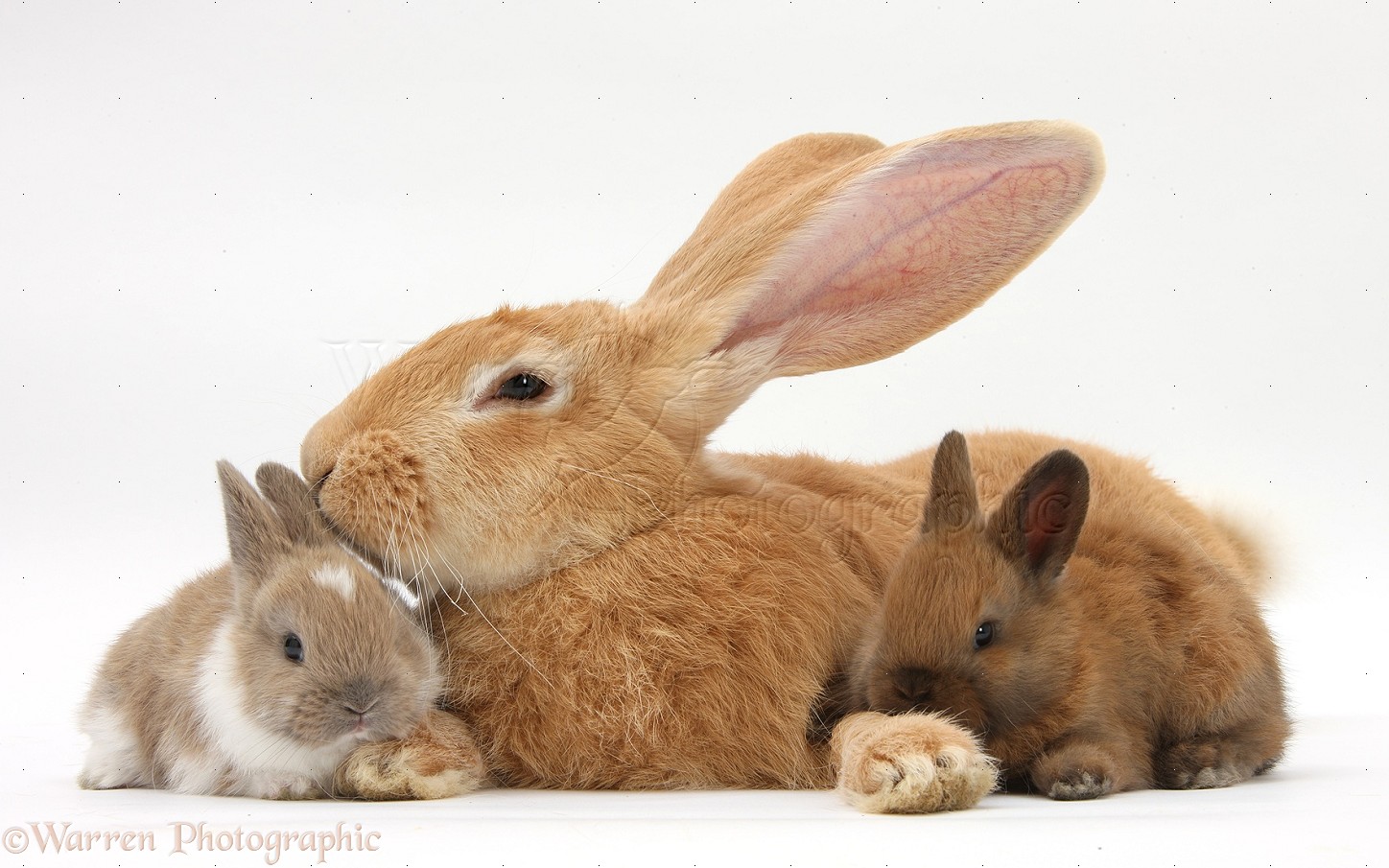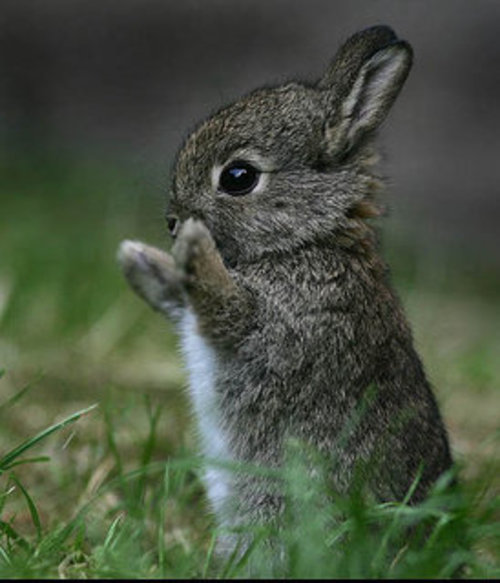Cute Baby Bunnies Biography
Source:- Google.com.pk
Many people purchase or adopt rabbits from sources that do not insist on spay/neuter beforehand, and even though the unsuspecting folks are assured that "they're both boys" or "they're both girls", and that the mounting behavior they observe is "just play"--we get surprises. If you come out one morning to find that your rabbit has given birth to a litter of babies, there are several steps you must take to ensure her health and the health and survival of her babies.
Step 1. Separate the parent rabbits so that the male can see/hear/interact with his mate, but not mate with her.
Keep the male nearby and able to nuzzle his mate through a physical barrier, if possible. Rabbits form very strong bonds with their mates, and separation can not only create unwanted stress and sadness for the rabbits, but also make it difficult to reintroduce the parents once they are spayed/neutered. Be sure mama and papa are able to interact, though they must not be allowed to mate again. Rabbits are "induced ovulators": the very act of mating induces ovulation, and makes pregnancy almost assured.
You're separating papa not because he might harm the babies (many rabbit fathers are very gentle and loving with baby rabbits), but because he can impregnate the mother again within hours after the birth. Because rabbit gestation is only 28 - 31 days, this means she'll give birth again before her first litter is weaned. It doesn't take much math to figure out that this is not good for the mother's health, nor that of either of her litters!
Step 2. Provide mama and her babies with a quiet, sheltered place where they will not be disturbed.
A seldom-used bathroom with a darkened corner for the nest box is ideal.
If mama has pulled her fur, it's because she is planning to use it to line the nest. If she hasn't made the nest yet, you can do it for her, and then place the babies in the nest. If mama has already made a nest, then leave it intact, and simply move it to the nest box.
A covered litterbox (the type used for cats) makes a good nest box. It should be lined with a towel on the bottom (but make sure the towel has no loose strings or holes, since babies can get tangled and strangled!) topped with a layer of soft hay or straw. The babies in their nest should be placed on top of the hay. Make sure mama sees where her babies are, and then let her choose what to do.
The box should be high enough so that the babies can't crawl out, but low enough to allow mama to easily hop in to nurse and hop out when she wants to get away.
NOTE THAT MAMA WILL NURSE ONLY ONCE OR TWICE PER DAY, AND THEN "IGNORE" THE BABIES. This does not mean that she has abandoned them. She is merely following her instinct to stay away from the nest to avoid drawing the attention of predators.
Don't assume that because you don't see her feeding the babies that she has abandoned them. It is her natural instinct to stay away from the nest. If the babies are warm and wiggly, and their bellies are round, you should not interfere. Bottle feeding almost invariably does more harm than good!
If the babies seem cold, shrunken, lethargic, and are more bluish than a healthy, pink color, mama might not be feeding them. Only then should you consider what to do about feeding an orphaned litter.
Step 3. Check the national House Rabbit Society web site's VETERINARIAN REFERRAL LISTINGS, find a rabbit-experienced vet near you, and set up an appointment to have papa neutered ASAP.
The sooner he's neutered, the sooner he'll be healed and ready to rejoin his family.
Be sure to keep papa separated from mama until there's no further danger of pregnancy: viable sperm can live in his internal reproductive tubes for three weeks (some vets believe it may be even longer!).
Step 4. Make sure mama has a varied bounty of unlimited food and water.
Feed mama unlimited pellets, leafy green vegetables and grass hay, and be sure she always has a plentiful supply of clean, fresh water.
The babies will begin to nibble at solid food as early as two weeks of age. However, they must not be weaned for a FULL EIGHT WEEKS AFTER BIRTH!
As rabbits begin to wean (between the ages of four to five weeks), they begin to ingest bacteria that will eventually become part of their normal gut "flora." At the same time, the pH of the intestine is changing, and the babies are ingesting many potentially harmful bacteria.
Mother's milk is designed to provide the babies with antibodies to kill pathogens (disease-causing agents) they ingest, and its pH changes as the babies get older. It is perfectly balanced to allow safe weaning.
Babies who are weaned younger than 8 weeks suffer a very high risk of enteritis (inflammation of the intestinal lining, resulting in fatal diarrhea), especially when stressed (as by the separation from family and introduction into a new home!). Don't subject the babies to an early death simply because they are "cute" at four weeks, and more appealing to potential adopters. A serious adopter will not mind waiting until the baby is fully weaned and ready to start life away from mama.
Step 5. Give mama a few weeks to recover from nursing once the babies are weaned, and then have her spayed by a competent rabbit vet.
Bring papa along for the ride, since the shared stress of hospitalization will help seal their bond and make it easier to reintroduce them at home. Spayed/neutered rabbits live longer, healthier lives, and can live together in snuggling bliss without the risk of unwanted litters or the constant stress of sexual frustration if only one is neutered or spayed.
Unspayed, unbred female rabbits have a very high risk of uterine/ovarian cancers, so even though papa is neutered, it is best to have mama spayed, too. Just give her plenty of time to recover after the babies are weaned.
Depending on breed, rabbits reach sexual maturity at the age of 3-5 months (males) or 5-8 months (females). Even before this time, however, some will begin to exert their more dominant personalities, and will fight with their littermates. When fighting starts, it's time to spay/neuter.
Males can be neutered as soon as the testicles descend (usually at the age of 3-4 months).
Females can be spayed as young as five months of age, but I personally prefer to wait until they are at least nine months old, since estrogen is involved in the normal development of the skeleton. Although no data exist to link early spays with osteoporosis later in life, I personally prefer to err on the side of caution until we know more about this potential problem.
Step 6. Buy a copy of The House Rabbit Handbook by Marinell Harriman.
It's available at most major bookstores for under $10, and is the most accurate, up-to-date rabbit book available. For more information on rabbit care, visit the House Rabbit Society, where volunteers are online to answer all your rabbit-related questions.
Cute Baby Bunnies Cute Babies Pictures With Love Quotes Wallpapers With Pink Dress Wallpapers Images With Purple Dress And Puppies

Cute Baby Bunnies Cute Babies Pictures With Love Quotes Wallpapers With Pink Dress Wallpapers Images With Purple Dress And Puppies

Cute Baby Bunnies Cute Babies Pictures With Love Quotes Wallpapers With Pink Dress Wallpapers Images With Purple Dress And Puppies

Cute Baby Bunnies Cute Babies Pictures With Love Quotes Wallpapers With Pink Dress Wallpapers Images With Purple Dress And Puppies

Cute Baby Bunnies Cute Babies Pictures With Love Quotes Wallpapers With Pink Dress Wallpapers Images With Purple Dress And Puppies

Cute Baby Bunnies Cute Babies Pictures With Love Quotes Wallpapers With Pink Dress Wallpapers Images With Purple Dress And Puppies

Cute Baby Bunnies Cute Babies Pictures With Love Quotes Wallpapers With Pink Dress Wallpapers Images With Purple Dress And Puppies

Cute Baby Bunnies Cute Babies Pictures With Love Quotes Wallpapers With Pink Dress Wallpapers Images With Purple Dress And Puppies

Cute Baby Bunnies Cute Babies Pictures With Love Quotes Wallpapers With Pink Dress Wallpapers Images With Purple Dress And Puppies

Cute Baby Bunnies Cute Babies Pictures With Love Quotes Wallpapers With Pink Dress Wallpapers Images With Purple Dress And Puppies

Cute Baby Bunnies Cute Babies Pictures With Love Quotes Wallpapers With Pink Dress Wallpapers Images With Purple Dress And Puppies
No comments:
Post a Comment